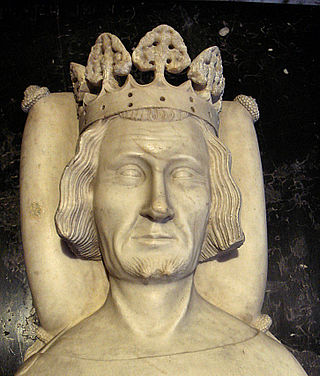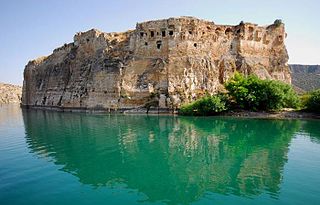
Kozan, formerly Sis, is a municipality and district of Adana Province, Turkey. Its area is 1,903 km2, and its population is 132,703 (2022). It is 68 kilometres northeast of Adana, in the northern section of the Çukurova plain. The Kilgen River, a tributary of the Ceyhan, flows through Kozan and crosses the plain south into the Mediterranean. The Taurus Mountains rise up sharply behind the town.

The Ayyubid dynasty, also known as the Ayyubid Sultanate, was the founding dynasty of the medieval Sultanate of Egypt established by Saladin in 1171, following his abolition of the Fatimid Caliphate of Egypt. A Sunni Muslim of Kurdish origin, Saladin had originally served the Zengid ruler Nur ad-Din, leading Nur ad-Din's army in battle against the Crusaders in Fatimid Egypt, where he was made Vizier. Following Nur ad-Din's death, Saladin was proclaimed as the first Sultan of Egypt by the Abbasid Caliphate, and rapidly expanded the new sultanate beyond the frontiers of Egypt to encompass most of the Levant, in addition to Hijaz, Yemen, northern Nubia, Tarabulus, Cyrenaica, southern Anatolia, and northern Iraq, the homeland of his Kurdish family. By virtue of his sultanate including Hijaz, the location of the Islamic holy cities of Mecca and Medina, he was the first ruler to be hailed as the Custodian of the Two Holy Mosques, a title that would be held by all subsequent sultans of Egypt until the Ottoman conquest of 1517. Saladin's military campaigns in the first decade of his rule, aimed at uniting the various Arab and Muslim states in the region against the Crusaders, set the general borders and sphere of influence of the sultanate of Egypt for the almost three and a half centuries of its existence. Most of the Crusader states, including the Kingdom of Jerusalem, fell to Saladin after his victory at the Battle of Hattin in 1187. However, the Crusaders reconquered the coast of Palestine in the 1190s.

Leo V or Levon V, of the House of Lusignan, was the last Latin king of the Armenian Kingdom of Cilicia. Leo was described as "Leo V, King of Armenia" on his own personal seal, and as "Leo of Lusignan the Fifth" in the Middle French inscription on his cenotaph: Leon de Lizingnen quint.

Hethum II, also known by several other romanizations, was king of the Armenian Kingdom of Cilicia, ruling from 1289 to 1293, 1295 to 1296 and 1299 to 1303, while Armenia was a subject state of the Mongol Empire. He abdicated twice in order to take vows in the Franciscan order, while still remaining the power behind the throne as "Grand Baron of Armenia" and later as Regent for his nephew. He was the son of Leo II of Armenia and Kyranna de Lampron, and was part of the Hethumid dynasty, being the grandson of Hethum I, who had originally submitted Cilicia to the Mongols in 1247. He was assassinated with his nephew and successor Leo III by the Mongol general Bilarghu, who himself was later executed for this by the Mongol Ilkhan ruler Öljaitü.

Rumkale, also known as Urumgala, is a fortress on the Euphrates, located in the province of Gaziantep and 50 km west of Şanlıurfa.

Qalāwūn aṣ-Ṣāliḥī was the seventh Turkic Bahri Mamluk Sultan of Egypt; he ruled from 1279 to 1290. He was called al-Manṣūr Qalāwūn. After having risen in power in the Mamluk court and elite circles, Qalawun eventually held the title of "the victorious king" and gained de facto authority over the sultanate. He is the founder of the Qalawunid dynasty that ruled Egypt for over a century.

The Bahri Mamluks, sometimes referred to as the Bahri dynasty, were the rulers of the Mamluk Sultanate of Egypt from 1250 to 1382, following the Ayyubid dynasty. The members of the Mamluk ruling class were purchased as slaves (mamluks) and manumitted, with the most powerful among them taking the role of sultan in Cairo. While several Bahri Mamluk sultans tried to establish hereditary dynasties through their sons, these attempts were ultimately unsuccessful, with the role of sultan often passing on to another powerful Mamluk.

The Burji Mamluks or Circassian Mamluks, sometimes referred to as the Burji dynasty, were the rulers of the Mamluk Sultanate of Egypt from 1382 until 1517. As with the preceding Bahri Mamluks, the members of the Burji Mamluk ruling class were purchased as slaves (mamluks) and manumitted, with the most powerful among them taking the role of sultan in Cairo. During this period, the ruling Mamluks were generally of Circassian origin, drawn from the Christian population of the northern Caucasus. The name Burji, meaning 'of the tower', refers to the traditional residence of these Mamluks in the barracks of the Citadel of Cairo.

The Armenian Kingdom of Cilicia, also known as Cilician Armenia, Lesser Armenia, Little Armenia or New Armenia, and formerly known as the Armenian Principality of Cilicia, was an Armenian state formed during the High Middle Ages by Armenian refugees fleeing the Seljuk invasion of Armenia. Located outside the Armenian Highlands and distinct from the Kingdom of Armenia of antiquity, it was centered in the Cilicia region northwest of the Gulf of Alexandretta.

Al-Ashraf Salāh ad-Dīn Khalil ibn Qalawūn was the eighth Turkic Bahri Mamluk sultan, succeeding his father Qalawun. He served from 12 November 1290 until his assassination in December 1293. He was well known for conquering the last of the Crusader states in Palestine after the siege of Acre in 1291. While walking with a friend, Khalil was attacked and assassinated by Baydara and his followers, who was then killed under the orders of Kitbugha.

Al-Malik an-Nasir Nasir ad-Din Muhammad ibn Qalawun, commonly known as an-Nasir Muhammad, or by his kunya: Abu al-Ma'ali or as Ibn Qalawun (1285–1341) was the ninth Mamluk sultan of the Bahri dynasty who ruled Egypt between 1293–1294, 1299–1309, and 1310 until his death in 1341. During his first reign he was dominated by Kitbugha and al-Shuja‘i, while during his second reign he was dominated by Baibars and Salar. Not wanting to be dominated or deprived of his full rights as a sultan by his third reign, an-Nasir executed Baibars and accepted the resignation of Salar as vice Sultan.

Besni is a town of Adıyaman Province of Turkey, 44 km west of the city of Adıyaman. It is the seat of Besni District. Its population is 37,323 (2021).
The Ramadanid Emirate was an autonomous administration and a de facto independent emirate that existed from 1352 to 1608 in Cilicia, taking over the rule of the region from the Armenian Kingdom of Cilicia. The emirate was a protectorate of the Mamluk Sultanate until the end of the 14th century, then it was de facto independent for more than a century, and then, from 1517, a protectorate of the Ottoman Empire. The capital was Adana.

Al-Malik al-Zahir Rukn al-Din Baybars al-Bunduqdari, commonly known as Baibars or Baybars and nicknamed Abu al-Futuh, was the fourth Mamluk sultan of Egypt and Syria, of Turkic Kipchak origin, in the Bahri dynasty, succeeding Qutuz. He was one of the commanders of the Egyptian forces that inflicted a defeat on the Seventh Crusade of King Louis IX of France. He also led the vanguard of the Egyptian army at the Battle of Ain Jalut in 1260, which marked the first substantial defeat of the Mongol army and is considered a turning point in history.

Al-Ashraf Zayn ad-Din Abu al-Ma'ali Sha'ban ibn Husayn ibn Muhammad ibn Qalawun (Arabic: الأشرف زين الدين شعبان, lit. 'The Most Noble, Grace of the Faith, Father of Excellence, Sha'ban son of Husayn, son of Muhammad, son of Qalawun', better known as al-Ashraf Sha'ban (السلطان شعبان or Sha'ban II, was a Mamluk sultan of the Bahri dynasty in 1363–1377. He was a grandson of Sultan an-Nasir Muhammad. He had two sons who succeeded him: al-Mansur Ali and as-Salih Hajji.

Sis was the capital of the Armenian Kingdom of Cilicia. The massive fortified complex is just to the southwest of the modern Turkish town of Kozan in Adana Province.

Mongol Armenia or Ilkhanid Armenia refers to the period beginning in the early-to-mid 13th century during which both Zakarid Armenia and the Armenian Kingdom of Cilicia became tributary and vassal to the Mongol Empire and the successor Ilkhanate. Armenia and Cilicia remained under Mongol influence until around 1335.
Shah Suwar was the ruler of Dulkadir from April 1466 to 4 June 1472. Upon the assassination of his brother, Malik Arslan, he competed with his other brother Shah Budak, who was backed by the Mamluk Sultanate. On the other hand, Shah Suwar was welcomed by the Ottoman Sultan Mehmed II, who appointed him to a number of positions in his realm. Soon after Shah Budak's takeover of the throne, Shah Suwar defeated him and instead became the new ruler in April 1466. The Mamluks fiercely disputed his reign. The Sultans Khushqadam and Qaitbay launched multiple consecutive campaigns to subdue him. Shah Suwar initially triumphed over the Mamluks and expanded his territory, occupying the entirety of the Ramadanid realm.
The siege of Rumkale or the fall of Rumkale took place in 1292 and resulted in the Armenian Kingdom of Cilicia losing the castle of Rumkale to the Mamluk Sultanate.

The Military of the Mamluk Sultanate, officially known as Al-Asakir al-Masria or Al-Askar al-Masri or Al-Jund al-Masri or Al-Asakir al-Mansoura, was the official armed forces of the Egyptian Mamluk Sultanate.















